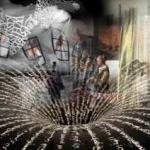Veins of Porcelain: The Letter Torn by Silence
Veins of Porcelain: The Letter Torn by Silence reinterprets Vermeer’s Girl Reading a Letter at an Open Window as a surreal descent into language, memory, and fragmentation. The girl stands at the edge of a vortex of collapsing script—Arabic, Latin, Persian—all spiraling into darkness. Floating windows, fractured texts, and ghostly figures swirl around her, transforming the room into a chamber of inherited silence. Monochrome greys and golden light clash in emotional tension, while the letter she reads becomes a relic of lost narratives. This reimagination makes reading an act of excavation—of ancestral voices, broken stories, and the fragile truths that tremble between ink and forgetting.
Please see Below for Details…
Hotline Order:
Mon - Fri: 07AM - 06PM
404-872-4663
Veins of Porcelain: The Letter Torn by Silence reimagines Johannes Vermeer’s Girl Reading a Letter at an Open Window as a metaphysical unraveling of language, isolation, and perception. The once quiet interior—Vermeer’s hallmark of restraint and poetic light—is now consumed by a vortex of script, calligraphy, and suspended narrative. This surreal transformation breaks the fourth wall of history and collapses the notion of private reflection. The girl, no longer a solitary figure in quiet contemplation, now stands at the edge of a black hole of language. Her letter—once a private moment—is now the gravitational center of a cultural implosion, where pages, memories, and translations spiral beyond control.
In this composition, text becomes more than content—it becomes the medium, the gravity, and the distortion. Arabic calligraphy, Persian manuscripts, and Western script all melt into one another, spiraling around a dark abyss as if pulled by the emotional density of the unsaid. The room’s window frames, previously symbols of enlightenment, float in the air like shards of forgotten correspondence, twisted midair by the forces of memory and longing. The figures of past lives—soldiers, lovers, readers—are suspended between the ink and light, half-emerging, half-vanishing, as if erased mid-thought.
The color palette performs an emotional crescendo. Monochrome greys and dusky whites dominate the void where script collapses, embodying mourning, confusion, and forgotten voices. The text glows faintly with metallic silvers, cold like moonlight on empty parchment. As the viewer’s eye moves toward the girl, warmer ochres and antique golds reemerge, bathing her figure in Vermeer’s classic palette—but here, that warmth no longer offers clarity. It is instead the firelight of uncertainty, illuminating her skin as if she’s reading not just a letter, but the echo of the past written in tongues not her own. The shadows around her deepen into smoky blacks, suggesting that the act of reading is no longer innocent—it is ancestral, political, and inescapably haunted.
Behind her, the curtain no longer conceals, but reveals a scroll of overlapping cultures. Vermeer’s subtle geometry of room and frame is overtaken by a new architecture of language—one where stories aren’t told linearly, but in spirals, fractures, and echoes. The walls that once enclosed her into safety are now open skies for symbols to fly through. The once-open window is now a fractured field of floating frames, opening nowhere, pointing to everything. Even the original painting’s map on the back wall is replaced by metaphorical topographies—geographies of language, grief, exile, and hope.
As the artist, I approached this reinterpretation not to modernize Vermeer, but to interrogate the act of reading itself. In Vermeer’s world, the girl reads a letter and we imagine her lover, her longing, her solitude. But what if the letter is unreadable? What if it’s been translated too many times, or buried in the codes of languages we no longer speak? This piece is about the collapse of knowing. About the beauty and despair that come when words fail us—when what we read is not what was written, and what was written was already censored by time.
I imagined the letter she holds as a relic, not from a man, but from a lost archive. From a place or time where love was written in the margins of exile, from across borders, from tongues forbidden. And as she reads, her world splits—not with fear, but with recognition. This isn’t just a girl reading. This is every daughter, every reader, every soul who has tried to piece together a broken inheritance through language and silence.
The spiral of text descending into the black hole is intentional—it is both metaphor and memory. It suggests that every letter is part of something deeper: a gravity made from all the stories we weren’t allowed to finish. The words around her aren't just lost—they're circling, waiting, rewriting themselves in new tongues. Vermeer’s soft realism becomes a platform for metaphysical excavation, for a surreal descent into collective memory.
Veins of Porcelain: The Letter Torn by Silence transforms Girl Reading a Letter at an Open Window into a symphony of script and disappearance. It speaks to the fragile power of words, especially those written but never spoken aloud. And in this space, the girl is not passive. She is the reader of the void. The interpreter of generations. The one who holds the letter and chooses to understand it, even as it tries to vanish in her hands.
Add your review
Your email address will not be published. Required fields are marked *
Please login to write review!
Looks like there are no reviews yet.










